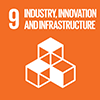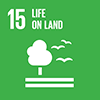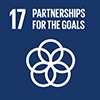June 2022 - You are accessing an old version of our website. The SDGs Voluntary Commitments have been migrated here: https://sdgs.un.org/partnerships
You will be redirected to the new Partnership Platform in 10 seconds.
June 2022 - You are accessing an old version of our website. The SDGs Voluntary Commitments have been migrated here: https://sdgs.un.org/partnerships
You will be redirected to the new Partnership Platform in 10 seconds.
Suzano, world leader in market eucalyptus pulp, has an innovative Restoration Program, which seeks to restore degraded habitat and promote environmental conservation of ecosystems in four out of the six Brazilian biomes (Amazon Rainforest, Atlantic Forest, Cerrado and Caatinga). In nearly a decade, over 10.7 million native seedlings were planted, starting the restoration process for 31,200 hectares. Also, Suzano’s preservation areas encompass over 925,600 hectares, 38% of its total area. As such, Suzano’s sustainable environmental management increases afforestation and reforestation in Brazil, ensures conservation of important habitat including its biodiversity and watersheds, and strengthens Suzano’s adaptive-capacity to climate change.
In one of the countries that suffers the most significant deforestation in the world, Suzano is responsible for that which is among the largest private restoration programs. The objective of the Program is to transform degraded, pastureland that provides few ecosystem services into regenerative, native Brazilian vegetation that is an integral part of the company’s business model. Suzano plants eucalyptus in over 1.011 million hectares with the goal to produce pulp that is then transformed into forest products such as toilet paper, tissue, lignin, printing and writing paper, among others.
Planting eucalyptus interspersed with native vegetation provides for more value for the company, biodiversity and society. The benefits generated by this model, and specifically from the Restoration Program, comes in many forms and all of them touch upon specific targets of the Sustainable Development Goals (SDGs). They are:
- Conservation of important habitats with their biodiversity, including endangered and threatened species, restoration of degraded soil and protection against erosion (SDG15.1 and 15.3);
- Afforestation and reforestation in Brazil aligned with the country’s Nationally Determined Contribution (NDC) to the Paris Agreement, which includes a specific target to restore 12 million hectares and recover more than 5 million hectares of degraded pastureland until 2020 (SDG15.2);
- Protection of watersheds and conservation of water sources, ensuring the availability and quality of water (SDG 6.1 and 6.6);
- Increase in carbon capture and storage, therefore contributing to improving Suzano’s mitigation capacity (SDG 13.3);
- Income-generation in vulnerable, rural communities through capacity-building and support for locals to produce, sell and plant native seedlings that are then purchased and used by the company’s Restoration Program (SDG 1.1);
- Enhance scientific research, upgrade the technological capabilities to reduce environmental impact and guarantee forest cover success (SDG 9.5); and
- Mobilize and share knowledge, best practices and technology with multi-stakeholder parties that range from local communities, NGOs, universities, other companies to ensure the achievement of the Brazilian restoration goals in biomes (SDG 17.7 and 17.16)
Forest restoration aims to provide greater biodiversity and generate numerous environmental services such as water availability, climate regulation, protection from natural hazards, erosion control, control of pests and diseases, among others, bringing benefits to the company and society. Furthermore, in order to guide its strategy and ensure knowledge sharing, Suzano establishes public commitments including the signature of the Atlantic Forest Restoration Pact, which predicts the recovery of 15 million hectares of the Atlantic Forest biome in the country until 2050. The Atlantic Forest is one of the most biodiverse biomes in the planet, of which only 12.4% of its original cover is left
Given restoration’s complexity, where many skillsets and views are necessary. For each region in which the Program is present there is a diverse network of partners that includes NGOs (e.g. WWF, The Nature Conservancy, WRI), academia (e.g. UNESP and USP-ESALQ), financial institutions, customers, local communities and SMEs. In this way, this partnership chain supports, promotes and innovates on restoration technology and methodologies seeking to improve efficiency, reduce environmental impacts, generate job opportunities and knowledge sharing to create specific methodologies for each of the biomes, considering their unique soil, water resources, climate and socio-environmental characteristics.
Suzano understands that restoration is a commitment and a responsibility in the regions in which it operates. As such, the company has designed a Restoration Program that seeks to incorporate local specificities to ensure overall efficiency and effectiveness in the transformation of degraded pastureland into mature, native vegetation.
The Program is integrated into Suzano’s overreaching conservation strategy that includes 925,600 hectares of native vegetation dedicated exclusively to environmental conservation, in the form of Legal Reserves, Permanent Preservation Areas and Private Natural Heritage Reserves, among others. This sizeable portion of forest is 38% of the Company’s total area and is above what is legally required in Brazil. Note that these conservation and restoration areas are interspersed with eucalyptus plantations in order to produce forests mosaics that help maintain balance of the ecosystem.
The company establishes procedures for restoration and conducts the best practices available in a cost-effective manner, as a certified forest company (FSC, PEFC and ISO), These include:
- Annual prioritization of projects considering soil evaluation, water resource protection, connectivity to biodiversity corridors, operational logistics planning, local socio-economic characteristics, legal requirements, amongst others
- Four restoration methods implemented depending on the degree of natural regeneration and invasive species infestation. (1) Native tree planting, (2) Assisted natural regeneration, (3) Control of exotic species, and (4) Isolation and abandonment. All strategies aim to increase forest cover and local biodiversity.
- Extensive analysis conducted to protect against threats such as cattle, forest fires, pests, poaching and illegal logging, including strategies of fencing and use of monitoring cameras
- Maintenance practices are tracked through KPIs consolidated in periodic reports to management to ensure effectiveness of the adopted restoration strategy
- Operational monitoring applied regularly over the first five years of restoration to assess the quality of the operations performed, seedling survival, incidence of pests (especially cutting ants) and intensity of weed competition. The operational monitoring is conducted by a specialized surveillance and protection team, which recommends adjustments to silvicultural operations and engenders consolidated monthly reports enabling managers to act on quality deviations of each area and monitor project accomplishments.
- Ecological monitoring, which should be applied approximately five years after beginning the restoration process, aims to assess if there is need for further interventions in the area, e.g. species enrichment, additional coverage planting, control of invasive species
This strategy includes creating partnerships in diverse sectors, some examples below. Together with Unesp, a Brazilian University, Suzano developed a monitoring system for the Cerrado, Brazil’s second largest natural biome, where the loss of vegetation coverage is as high as 51%. A long-term technical cooperation with TNC includes satellite monitoring of restoration areas in Maranhão and Bahia. Suzano also works with community cooperatives that provide native seedlings to be planted in the restoration processes. Thus, this initiative promotes income generation and decent work. Lastly, the partnership with Wooly Spider Monkey Association in São Paulo ensures the protection of this endangered species.
Suzano has an Annual Restoration Plan with specific annual targets that have resulted in 10.7 million native seedlings planted in 31,200 hectares undergoing restoration from degraded land and soil, spread out across 1,335 rural properties managed by Suzano. It is estimated that after 30 years, these areas will contribute to climate change by removing approximately 22 million tCO2e (~709.29 TonCO2e/ha) from the atmosphere. The Company has a plan to continue its restoration initiative in other degraded areas within managed properties.
The recovery of native ecosystem coverage fostered by Suzano’s Restoration Program, together with its conservation areas, promotes the improvement of ecosystem services including: provision of water, water purification, biological control of pests and diseases, local and regional climate regulation, air quality, carbon sequestration and storage, pollination, moderation of extreme events, erosion prevention and maintenance of soil fertility, habitat for species and maintenance of genetic diversity.
The Program contributes to the creation of ecological corridors, which integrate the restoration initiatives with other conservation areas within the Company and connect these to other conservation areas including state and federal parks. Together, these conservation areas contribute to the enrichment of fauna and flora biodiversity. An emblematic example is Neblinas Park, 6,000 hectares private reserve owned by Suzano, located near São Paulo. The park conserves the Itatinga River Basin and promotes scientific research, forest management, socio-environmental education, protection of biodiversity, restoration of the Atlantic Forest and visitation.
As a result of such monitoring, over 246 endangered species were recorded within company-managed, conservation areas. In addition, the company has set up a rich database of over 800 species of birds, 156 species of mammals and 2,000 species of plants, all of which were also recorded in company-managed, conservation areas. In early 2018, researchers discovered a new tree species, a type of cinnamon tree part of the Lauraceae family, at a company farm in the interior region of the state of São Paulo. Pioneering surveys, constant monitoring and innovative environment conservation methods yield increasingly more significant benefits, with important results for ecosystems and for Suzano.
Mucuri Springs Project is a key initiative that exemplifies Suzano’s restoration with additional benefits and positive externalities. The Mucuri River Basin has suffered a reduction in water availability in the last few years that is a result of deforestation carried out by grazing and agriculture, which compromised the water supply for the population and Suzano’s Bahia mill (SDG 6.b). The project aims to promote efforts in environmental education and qualification of local producers to consolidate a culture of preservation, design public policies and foster strategic partnerships to stimulate the entire restoration chain in the region. The project aims to restore 2,500 headwaters in five years and recover nearly 19,000 hectares of degraded lands around those springs. It is estimated that the project will remove 540,000 tCO2e and contribute to the regional climate change agenda. To this date, 44 headwaters have been recovered, over 29,000 seedlings planted and 6,715 people were engaged and involved.
Given the Restoration Program’s complexity and geographical extension, it requires significant mobilization of resources including technology, human and intellectual capital, financing costs and materials.
An emblematic example is the mobilization of financial resources through two separate emissions of Green Bonds (SDG 15.a). Suzano was the first Latin American company to issue green bonds in US dollar in 2016, and is the largest Brazilian issuer of Green Bonds up to date. Both operations successfully raised in total US$ 1.4 billion. The proceeds have been and will continue to fund environmental projects that meet certain eligibility criteria, one of which deals with conservation and restoration of natural ecosystems. Thus, the Green Bonds are an important enabling factor that anticipates the targets established in the Annual Restoration Plan, allows the investment in technological innovation and guarantees the financial sustainability of the Program.
The company also invests constantly in technological advances that help improve the fundamental aspects of environmental management related to its restoration processes. The company was one of the first to use Light Detection and Ranging (LIDAR) technology for restoration purposes in Brazil. It captures images from laser instruments aboard small aircrafts capable of flying over large areas over short periods of time. The aircrafts have GPS equipment and the data collected is sent to a software program that analyzes and classifies the images according to land use characteristics, such as pasture, exposed soil or preservation area. With the help of other tools, such as drones and GISagri app, it is possible to evaluate and plan restoration activities faster and with greater precision. Detailed images provide an accurate picture including places that require greater weed control, which interfere with plant growth, and help define the best restoration methodology for each project. Enabling technological advancements, such as LIDAR, ensure precision, effectiveness and success of the overall Restoration Program.
Given the Program’s consolidated methodology, high success rate, and mature partner network, several institutions, research centers and universities reach out to Suzano seeking to develop research that improves the restoration practices already in place.
As an example, in partnership with Viçosa Federal University, Suzano developed innovative recommendations for monitoring the forest restoration and generation of adaptive management through images obtained by Unmanned Aerial Vehicle (UAV) and LIDAR technologies. This work in Bahia state suggests better indicators for rapid and cost-effective measurement of restoration process quality, and determines reference values for forest density and species richness, which can better indicate the necessity to make additional actions to increment the local biodiversity. Research practices, such as the partnership with Viçosa Univiersity, ensure the constant improvement of practices as well as knowledge-sharing between different players concerned with conservation of natural ecosystems in Brazil (SDG 9.b).
The Restoration Program in its essence promotes sustainability through the restoration of natural capital and its inherent ecosystem services. Through acquired knowledge from nearly a decade of intensive work, Suzano constantly improves the practices regarding recovery and of degraded areas in order to ensure more forest cover and connectivity. However, the company understands that it needs to engage and exchange knowledge with its network of partners to be better equipped to deal with ecological challenges and to increase the sustainability and replicability of its initiatives across Brazil and potentially in similar biomes in other countries. Suzano understands that these practices, commitments and partnerships can leverage the achievement of the restoration targets in the Brazilian NDC established and contribute to the Paris Agreement.
Two important examples are The Forests Dialogue, which gathers international players to share best practices and knowledge about sustainable forest stewardship, and the Brazilian Coalition for Climate, Forests and Agriculture, a multi-sector movement that promotes a new economic development model based on low-carbon economy.
Beyond the environmental benefits, Suzano is also concerned with the local socio-economic dynamics. It adopts social strategies depending on local specificities that include, but are not limited to, local job generation, professional qualification and training, commitment to buy seedlings from local community nurseries, environmental education and awareness, and stimulate the restoration production chain in the country. In fact, Suzano’s Restoration Program employs over 400 own and outsourced workers that are trained and qualified to guarantee the effectiveness of the restoration process.
Another factor that ensure the Program’s replicability and scale is its cost-benefit analysis. It provides an optimum tradeoff, since each project is thoroughly evaluated and prepared in accordance with the possibilities and needs of each area. The average cost of restoration per hectare is currently US$1,716, which is compatible with the company’s budget and financing mechanisms. In 2019, approximately US$9.4 million will be invested Suzano’s Restoration Program (SDG 15.a).
Suzano, a company that has sown its growth path based on sustainable practices, is a key supporter of protected areas in the global pulp and paper sector. Its Restoration Program is one of the largest, private initiatives in Brazil, responsible for initiating restoration processes in 31,200 hectares. In nearly a decade, over 10.7 million native seedlings were planted.
Suzano’s Environmental Strategy:
- Conserves critical habitats and its biodiversity in four of the six Brazilian biomes (Amazon, Atlantic Forest, Cerrado and Caatinga biomes (SDG 15.1);
- Increases afforestation, reforestation, carbon sequestration and storage, aligned with Brazil’s NDC. It is estimated that after 30 years, these areas will contribute to climate change by removing approximately 22 million tCO2e (~709.29 TonCO2e/ha) from the atmosphere. The Company has a plan to continue its restoration initiative in other degraded areas within managed properties (SDG15.2 and SDG 13.3);
- Protects local water resources and promotes conservation in watersheds, as exemplified in the Mucuri Springs Project that seeks to restore 2,500 headwaters (SDG 6.1 and 6.6);
- Enhances knowledge and research on restoration in Brazil focused on impact, including the application of UAV, LIDAR and drone technologies (SDG 9.5);
- Generates income in vulnerable, rural communities by providing qualified job opportunities and stimulating community nurseries for native trees, (SDG 1.1); and
- Mobilizes knowledge sharing with multi-stakeholder partnerships such as the Brazilian Coalition for Climate, Forests and Agriculture and the Atlantic Restoration Pact (SDG 17.7 and 17.16).
New forms of funding, like green bonds, and partnerships, such as those with Unesp, TNC and The Forest Dialogue, will continue to generate significant results, driving essential measures for rebalancing ecosystems, with lessons that are easily replicable in other regions affected by climate change and scarcity of resources. As such, Suzano’s Restoration Program plays a key role in protecting local habitat and its inherent biodiversity and contributing to the 2030 Agenda proposed by the SDGs. For Suzano, preserving biodiversity and mobilizing financial resources for environmental conservation are not only fundamental missions, but also values that permeate all of its operations.
In conclusion, expanding investments in the recovery of degraded areas and restoring forests is an inherent part of its short-, medium- and long-term strategic planning. “Suzano’s Restoration Program reinforces company competitiveness, fosters conservation, improves ecosystem services, generates jobs and benefits society as whole. Multi-stakeholder partnership has and will continue to play a fundamental role in achieving positive results in the recovery of important, vulnerable and biodiverse ecosystems in Brazil and shape the future for landscape management,” says João Augusti, Executive Environmental Forestry Manager.
About Suzano
The company resulting from the merger of Suzano Pulp & Paper and Fibria, is committed to being a global reference in the sustainable use of natural resources. The world's leading producer of eucalyptus pulp and one of Latin America’s largest paper producers, Suzano exports to more than 80 countries and, through its products, plays a part in the lives of over two billion people. With ten mills and the joint operation Veracel, Suzano has annual installed capacity of 11 million tons of market pulp and 1.4 million tons of paper. Suzano has approximately 37,000 direct and indirect employees and for over 90 years has invested in innovative solutions based on eucalyptus cultivation that enable it to substitute the use of fossil-based materials with renewable bio-based materials. e NYSE in the United States.
Suzano. www.suzano.com.br
Restoration Program:
New Generation Plantations, RESTORATION IN BRAZIL’S ATLANTIC FOREST: Pulp and paper companies are helping to bring one of the world's most important biodiversity hotspots back to life. https://newgenerationplantations.exposure.co/rainforest-restoration-in-brazils-atlantic-forest
FSG. “Case Study: Cultivating Shared Value in Brazil’s Forestry Sector”, Chapter: Sustainable Forestry. http://fibria-institucional-qa.azurewebsites.net/wp-content/uploads/2018/04/Fibria_external_case_study_English_VF.pdf
Rainforest Restoration in Brazil’s Atlantic Forest. https://www.youtube.com/watch?v=inx6s_im-mw
Moraes, M. A. (Org.). 2016. Restauração de florestas e paisagens no Brasil. Brasília: UICN. https://portals.iucn.org/library/sites/library/files/documents/2016-025.pdf
Brazilian Coalition for Climate, Forests and Ag:
http://www.coalizaobr.com.br/home/index.php/en/sobre-a-coalizao-2/governance
Technologies:
- REIS, Bruna Paolinelli, M.Sc., Universidade Federal de Viçosa, July, 2017. “Monitoring of forest restoration areas and generation of adaptive management recommendations through images obtained by UAV and LIDAR”. http://www.locus.ufv.br/handle/123456789/15300
The Forest Dialogue:
“Tree Plantations in the Landscape (TPL) Dialogue in Brazil”. https://theforestsdialogue.org/publication/co-chairs-summary-tree-plantations-landscape-tpl-dialogue-brazil
Mucuri Springs:
GVCes. “Water Resources and the Mucuri River Basin – a study of the ecosystem services of water provision, water quality regulation and global climate regulation”. http://mediadrawer.gvces.com.br/tese-casos/original/09-cases_ciclo2017_tese_ingl_suzano_2.pdf
Suzano. http://www.suzano.com.br/suzano/en/suzano-pulp-and-paper-and-tnc-sign-partnership-for-recovery-of-the-mucuri-river-springs/
Website: http://www.nascentesdomucuri.com.br/
Neblinas Park:
http://www.ecofuturo.org.br/blog/projeto/parque-das-neblinas/o-parque/
Green Bonds:
Climate Bonds. https://www.climatebonds.net/2016/11/1st-green-bond-brazilian-currency-suzano-papel-celulose-brl1-bn-usd-294m-no2-suzano
Greenbonds Suzano 2017: http://ir.suzano.com.br/fck_temp/16_32/file/Suzano_Green_Bonds_Relat%C3%B3rio%20Anual%202017%20-%20EN.pdf
Green Bonds Fibria 2017: http://r2017.fibria.com.br/wp-content/uploads/2018/05/Fibria-2017-Report_GreenBond-1.pdf
Green Bonds Fibria 2016: http://www.fibria.com.br/r2016/pdf/Fibria2016_green-bonds-report_en.pdf





 Start: 01 April, 2009
Start: 01 April, 2009 Completion: 01 January, 0001
Completion: 01 January, 0001